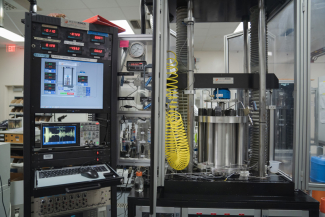
Located in UH’s Technology Bridge campus and funded through generous donations from Conoco-Phillips and with support from UH, students in the UH Petroleum Engineering department are able to gain real world skills in exceptional training and education facilities in Buildings 9 and 11. Building 9 was recently expanded to add near 25,000 square feet, including two teaching labs, a 70-seat classroom, and a 250-seat auditorium. Building 11 is a new addition to the Department that is dedicated to state-of-the-art research facilities for reservoir engineering including a flow loop laboratory and an experimental enhanced oil recovery laboratory and data visualization laboratory. The departmental facilities support the development and growth of the programs in the Department and enable continued evolution of technological innovation and advances. The facilities, by design, inspire collaborative interaction between the petroleum engineering student and faculty communities and industry and other research and education sponsors. The petroleum department facilities and laboratories support its mission of offering and expanding national and international opportunities for learning, discovery, and engagement to a diverse population of students in a real-world setting.
We invite you to view the following state-of-the-art laboratories: